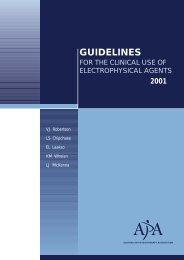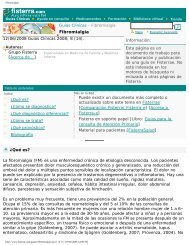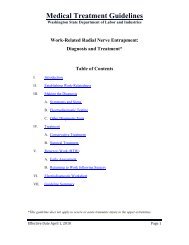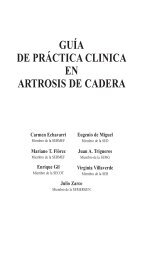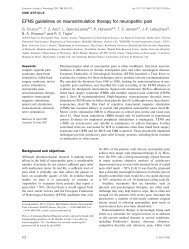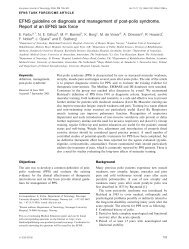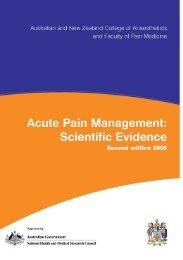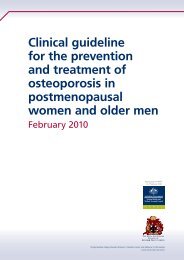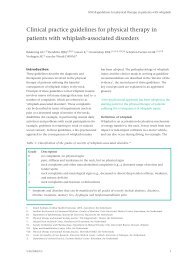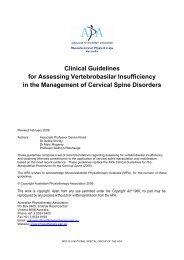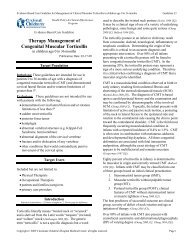Practice Parameter and Literature Review of the Usefulness of ...
Practice Parameter and Literature Review of the Usefulness of ...
Practice Parameter and Literature Review of the Usefulness of ...
You also want an ePaper? Increase the reach of your titles
YUMPU automatically turns print PDFs into web optimized ePapers that Google loves.
<strong>Practice</strong> <strong>Parameter</strong>: Carpal Tunnel Syndromeelectrodiagnosis.96. Hansson S. The association between nerve conduction velocity <strong>and</strong><strong>the</strong> compound action potential amplitude during ischemic blocking.Electromyogr Clin Neurophysiol 1999;39:113-122. Criteria Met (3/6:1,3,4) Source: Medline Search. Abstract: Ischemia was produced byinflating a tourniquet around <strong>the</strong> upper arm in five healthy subjects.When antidromic median sensory NCV <strong>and</strong> SNAP amplitudes wererecorded from <strong>the</strong> third digit with stimulation at <strong>the</strong> elbow, wrist <strong>and</strong>palm, <strong>the</strong> amplitude <strong>and</strong> CV decreased in parallel. This sequence <strong>of</strong>changes duplicates <strong>the</strong> blocking <strong>of</strong> nerve conduction during wristflexion in healthy subjects <strong>and</strong> CTS patients described previously(Hansson 1995).97. Hansson S, Nilsson BY. Median sensory nerve conduction blockduring wrist flexion in <strong>the</strong> carpal tunnel syndrome. Electromyogr ClinNeurophysiol 1995;35:99-105. Criteria Met (5/6: 1,2,3,5,6) Source:Medline Search. Abstract: Prospective study <strong>of</strong> <strong>the</strong> effect <strong>of</strong>prolonged passive wrist flexion on median <strong>and</strong> ulnar sensoryamplitude <strong>and</strong> latency in 10 normal controls <strong>and</strong> 30 CTS patients witha clinical diagnosis <strong>of</strong> CTS <strong>of</strong> whom 10 had mild abnormalities <strong>of</strong>median sensory latency measurements: digit wrist CV 0.4 ms.During prolonged (up to 45 min) passive wrist flexion, <strong>the</strong> antidromicmedian (wrist to 2nd finger) <strong>and</strong> ulnar (wrist to 5th finger) SNAPwere recorded. The measurements were made every 2.5 min duringsustained passive wrist flexion for up to 45 min <strong>and</strong> <strong>the</strong> time (T50) for<strong>the</strong> amplitude to fall to 50% <strong>of</strong> <strong>the</strong> initial amplitude determined. Themedian sensory conduction (but not <strong>the</strong> ulnar) became partiallyblocked in all CTS patients <strong>and</strong> also in 8 out <strong>of</strong> 10 controls. Mediansensory nerve conduction returned to normal in all subjects 30seconds after release <strong>of</strong> flexion. At 10 minutes <strong>of</strong> wrist flexion, nosignificant increase <strong>of</strong> <strong>the</strong> median SNAP peak latency in normalsubjects (mean 0.01 ± 0.04 ms) <strong>and</strong> CTS patients (mean 0.24 ± 0.26ms) was noted. The time (T50) necessary to reach a 50% reduction inmedian SNAP amplitude in 8 out <strong>of</strong> 10 probable CTS patients <strong>and</strong> in14 out <strong>of</strong> possible 20 CTS patients was below <strong>the</strong> lowest recordedvalue in <strong>the</strong> control group (25 min). It was shown that ischemiacaused <strong>the</strong> block (reduction in median SNAP amplitude) bydemonstrating (1) that <strong>the</strong> reversal <strong>of</strong> a 70% block with release <strong>of</strong>wrist flexion was prevented by inflating a pneumatic cuff around <strong>the</strong>upper arm to above systolic pressure for 5 minutes before release <strong>of</strong>wrist flexion after which (2) <strong>the</strong> SNAP amplitude returned to normal30 seconds after deflating <strong>the</strong> cuff. Determination <strong>of</strong> T50 <strong>of</strong> <strong>the</strong>median nerve SNAP during wrist flexion has <strong>the</strong> potential to add to<strong>the</strong> sensitivity <strong>and</strong> specificity <strong>of</strong> <strong>the</strong> electrophysiological diagnosis <strong>of</strong>CTS.98. Harmon RL, Naylor AH. Sensory <strong>and</strong> mixed nerve action potentialtemporal dispersion in median neuropathy at <strong>the</strong> wrist. Am J PhysMed Rehabil 1999;78:213-215. Criteria Met (1/6: 6) Source: MedlineSearch. Abstract: Retrospective study to determine <strong>the</strong> usefulness <strong>of</strong>measuring SNAP <strong>and</strong> mixed nerve AP temporal dispersion todiagnose CTS demonstrated that increased median mixed nerve APtemporal dispersion may occur in association with peak latencyprolongation in CTS. However, <strong>the</strong> small magnitude <strong>of</strong> <strong>the</strong> increasemakes <strong>the</strong> clinical usefulness <strong>of</strong> this observation unclear.99. Healy C, Watson JD, Longstaff A, Campbell MJ. Magnetic resonanceimaging <strong>of</strong> <strong>the</strong> carpal tunnel. J H<strong>and</strong> Surg Br 1990;15:243-248.Criteria Met (3/6: 1,2,3) Source: Medline Search.100. Herrick RT, Herrick SK. Thermography in <strong>the</strong> detection <strong>of</strong> carpaltunnel syndrome <strong>and</strong> o<strong>the</strong>r compressive neuropathies. J H<strong>and</strong> SurgAm 1987;12:943-949. Criteria Met (1/6: 1) Source: Medline Search.101. *Holmgren H, Rabow L. Internal neurolysis or ligament division onlyin carpal tunnel syndrome. II. A 3 year follow-up with an evaluation<strong>of</strong> various neurophysiological parameters for diagnosis. ActaNeurochir (Wien) 1987;87:44-47. Criteria Met (2/6: 1,2) Source:Medline Search.102. *Holmgren-Larsson H, Leszniewski W, Linden U, Rabow L,Thorling J. Internal neurolysis or ligament division only in carpaltunnel syndrome—results <strong>of</strong> a r<strong>and</strong>omized study. Act Neurochir(Wien) 1985;74:118-121. Criteria Met (0/6) Source: Holmgren, 1987.103. *Homan MM, Franzblau A, Werner RA, Albers JW, Armstrong TJ,Bromberg MB. Agreement between symptom surveys, physicalexamination procedures <strong>and</strong> electrodiagnostic findings for <strong>the</strong> carpaltunnel syndrome. Sc<strong>and</strong> J Work Environ Health 1999;25:115-124.Background Reference. Source: Medline Search. Abstract: The goal<strong>of</strong> this study was to evaluate <strong>the</strong> concordance between various clinicalscreening procedures for carpal tunnel syndrome. The subjectpopulation consisted <strong>of</strong> 824 workers from 6 facilities. The proceduresevaluated included bilateral median sensory nerve conduction testing,physical examinations, <strong>and</strong> symptom surveys, including h<strong>and</strong>diagrams. The agreement between <strong>the</strong> outcomes <strong>of</strong> variouscombinations <strong>of</strong> <strong>the</strong>se procedures was assessed by determining <strong>the</strong>kappa coefficient. There was relatively poor overlap between <strong>the</strong>reported symptoms, <strong>the</strong> physical examination findings, <strong>and</strong> <strong>the</strong>electrodiagnostic results consistent with carpal tunnel syndrome.Overall, only 23 out <strong>of</strong> 449 subjects (5%) with at least 1 positivefinding met all 3 criteria (symptoms, physical examination findings,<strong>and</strong> electrophysiological results consistent with carpal tunnelsyndrome) for <strong>the</strong> dominant h<strong>and</strong>. The screening procedures showedpoor or no agreement with kappa values ranging between 0.00 <strong>and</strong>0.18 for all <strong>the</strong> case definitions evaluated for carpal tunnel syndrome.The poor overlap between <strong>the</strong> various screening procedures warnsagainst <strong>the</strong> use <strong>of</strong> electrodiagnostic findings alone without <strong>the</strong>symptom presentation being considered. The results <strong>of</strong> this study alsopoint to a need for <strong>the</strong> fur<strong>the</strong>r development <strong>and</strong> evaluation <strong>of</strong> methodsfor detecting carpal tunnel syndrome.104. Hughes ACR. An evaluation <strong>of</strong> 2 electrodiagnostic procedures inpatients with symptoms <strong>of</strong> a carpal tunnel syndrome.Electroencephalogr Clin Neurophysiol 1977;43:140. Criteria Met(0/6) (abstract only) Source: AAEM Consultant 1993.105. *Imai T, Matsumoto H, Minami R. Asymptomatic ulnar neuropathyin carpal syndrome. Arch Phys Med Rehabil 1990;71:992-994.Criteria Met (3/6: 1,3,5) Source: Medline Search.106. Imaoka H, Yorifuji S, Takahashi M, Nakamura Y, Kitaguchi M, TaruiS. Improved inching method for <strong>the</strong> diagnosis <strong>and</strong> prognosis <strong>of</strong> carpaltunnel syndrome. Muscle Nerve 1992;15:318-324. Criteria Met (5/6:2,3,4,5,6) Source: Medline Search. Abstract: A modified sensory“inching” method for <strong>the</strong> electrodiagnosis <strong>of</strong> CTS is described. Themedian nerve as stimulated at <strong>the</strong> cubital segment with 8 channelrecording electrodes placed at 15 mm intervals along <strong>the</strong> mediannerve from a point 3 cm proximal to <strong>the</strong> distal wrist crease up to <strong>the</strong>middle finder. Eight consecutive SNAP were recorded <strong>and</strong> <strong>the</strong>negative peak latency measured. Each latency (ms) was plottedagainst distance (mm). The results were a linear relationship (1) fromchannel 1 to 8 in 32 normal subjects <strong>and</strong> (2) from channel 1 to at leastchannel 4 in CTS patients. In 73 <strong>of</strong> 84 (87%) limbs <strong>of</strong> CTS patients,<strong>the</strong>re was a conductive abnormality in <strong>the</strong> distal recordings asdetermined by discontinuous changes in <strong>the</strong> SNAP latency (greaterthan 0.6 ms) or amplitude (absence <strong>of</strong> response). The results suggestthat this method provides high sensitivity <strong>and</strong> specificity for <strong>the</strong>diagnosis <strong>of</strong> CTS. A prospective study with comparison to currenttechniques would help determine whe<strong>the</strong>r or not <strong>the</strong> technique hasadvantages over current recommended techniques.107. Iyer V, Fenichel GM. Normal median nerve proximal latency incarpal tunnel syndrome: a clue to coexisting Martin-Gruberanastomosis. J Neurol Neurosurg Psychiatry 1976;39:449-452.Background Reference. Source: AAEM Consultant 1993.108. Jablecki CK, Andary MT, Di Benedetto M, Horowitz SH, Marino RJ,Rosenbaum RB, Shields RW, Stevens JC, Williams FH. AmericanAssociation <strong>of</strong> Electrodiagnostic Medicine. Guidelines for outcomestudies in electrodiagnostic medicine. Muscle Nerve 1996;19:1626-1635. Source: AAEM 2000 CTS Task Force member.109. Jablecki CK, Andary MT, So YT, Wilkins DE, Williams FH.<strong>Literature</strong> review <strong>of</strong> <strong>the</strong> usefulness <strong>of</strong> nerve conduction studies <strong>and</strong>electromyography for <strong>the</strong> evaluation <strong>of</strong> patients with carpal tunnelsyndrome. Muscle Nerve 1993;16:1392-1444. Background Reference.Source: AAEM 2000 CTS Task Force member.110. Jackson D, Clifford JC. Electrodiagnosis <strong>of</strong> mild carpal tunnelsyndrome. Arch Phys Med Rehabil 1989;70:199-204. Criteria Met(6/6: 1,2,3,4,5,6) Source: Medline Search. Abstract: This studyevaluated <strong>the</strong> following techniques: (a) median nerve stimulation in<strong>the</strong> palm <strong>and</strong> recording proximal at <strong>the</strong> wrist (8 cm), (b) sensorylatency difference between median <strong>and</strong> radial stimulation at <strong>the</strong> wrist<strong>and</strong> recording on <strong>the</strong> thumb (10 cm), (c) medial-ulnar sensory latencydifference with stimulation at <strong>the</strong> wrist <strong>and</strong> recording on <strong>the</strong> ringfinger (14 cm), (d) median-ulnar sensory latency difference withstimulation in <strong>the</strong> palm <strong>and</strong> recording at <strong>the</strong> wrist (8 cm), <strong>and</strong> (e)Muscle & Nerve Supplement X 2002 S965



